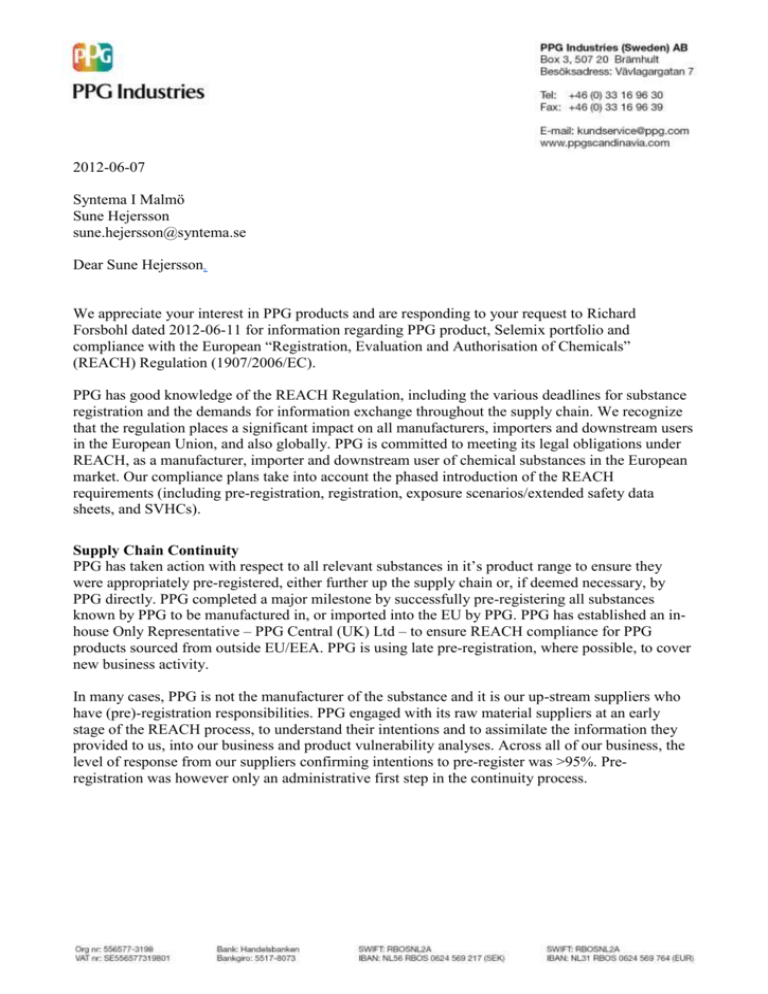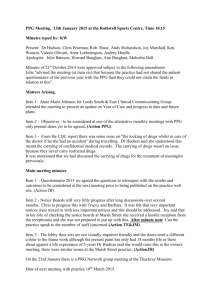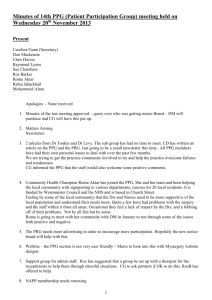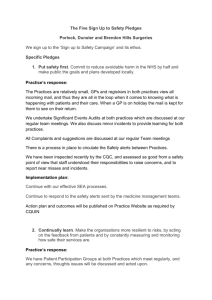2012-06-07
advertisement

2012-06-07 Syntema I Malmö Sune Hejersson sune.hejersson@syntema.se Dear Sune Hejersson, We appreciate your interest in PPG products and are responding to your request to Richard Forsbohl dated 2012-06-11 for information regarding PPG product, Selemix portfolio and compliance with the European “Registration, Evaluation and Authorisation of Chemicals” (REACH) Regulation (1907/2006/EC). PPG has good knowledge of the REACH Regulation, including the various deadlines for substance registration and the demands for information exchange throughout the supply chain. We recognize that the regulation places a significant impact on all manufacturers, importers and downstream users in the European Union, and also globally. PPG is committed to meeting its legal obligations under REACH, as a manufacturer, importer and downstream user of chemical substances in the European market. Our compliance plans take into account the phased introduction of the REACH requirements (including pre-registration, registration, exposure scenarios/extended safety data sheets, and SVHCs). Supply Chain Continuity PPG has taken action with respect to all relevant substances in it’s product range to ensure they were appropriately pre-registered, either further up the supply chain or, if deemed necessary, by PPG directly. PPG completed a major milestone by successfully pre-registering all substances known by PPG to be manufactured in, or imported into the EU by PPG. PPG has established an inhouse Only Representative – PPG Central (UK) Ltd – to ensure REACH compliance for PPG products sourced from outside EU/EEA. PPG is using late pre-registration, where possible, to cover new business activity. In many cases, PPG is not the manufacturer of the substance and it is our up-stream suppliers who have (pre)-registration responsibilities. PPG engaged with its raw material suppliers at an early stage of the REACH process, to understand their intentions and to assimilate the information they provided to us, into our business and product vulnerability analyses. Across all of our business, the level of response from our suppliers confirming intentions to pre-register was >95%. Preregistration was however only an administrative first step in the continuity process. Registration Following the first registration deadline in December 2010, we can confirm that we have experienced no significant disruption to our activities. PPG successfully registered all of the substances for which it had 2010 registration obligations prior to the deadline, and has received registration numbers for them (the sign that the registration is “complete”). These numbers will be made available via the appropriate SDSs. ECHA published a list of substances with a 2010 deadline (http://echa.europa.eu/chem_data/list_registration_2010_en.asp) and also of the substances that have been registered (http://apps.echa.europa.eu/registered/registered-sub.aspx#phasein) in reality. Although this is helpful, the list does not specify which manufacturer/importer did the registration, so it cannot be judged whether the registration was done in PPG’s supply chain. Obviously it is the obligation of the substance manufacturer/importer to correctly and timely register his substances. Continued supply of substances to downstream users and finally to raw materials for PPG’s products is regarded proof of correct and timely registration. We continue communications with our suppliers because we anticipate that some materials may be withdrawn due to poor pay-back from registration costs, product rationalisation or loss of critical ingredients further up their supply chain. We therefore continue developing contingency plans for products where we have doubts about the continuing supply of key raw materials. Exposure Scenarios and Identified Use PPG aims to support all intended uses of our products and substances contained therein of which we are currently aware. We have been taking an active part in discussions with stakeholders, including industry associations, in order to develop an effective and efficient means of communication on identified use and exposure scenarios. For further details consult the CEFIC (http://cefic.org/en/REACH-context.html) and CEPE (http://www.cepe.org) websites. We can confirm that we have written to all our European suppliers to inform them of the identified uses relevant to our (and our customer’s) activities, and request that these identified uses are included in their registration dossiers. The list of uses is available on the CEPE website. It is the obligation of the manufacturer/importer of a registered substance to establish Exposure Scenarios (ESs) for all uses of substances1 that he has been made aware of (and that he has accepted), and to report those ESs via the Extended Safety Data Sheet (ESDS) of the substance. The next link in the chain must subsequently forward these ESs, or the information contained therein, as well. The final formulator legally has the choice out of three options: 1. Attach all ESs of substances to the SDS of the mixture. 2. Prepare an ES for the mixture and attach that to the SDS. 3. Integrate the ES information into the body of the SDS. Current experiences show that ESs and ExtSDSs are becoming very long (dozens or more pages), making it an unpractical tool to assess the safety measures while using the final mixture. Work is ongoing on the preparation of formats for Exposure Scenarios for mixtures, using standard 1 This only applies to substances that must be registered and that are manufactured/imported in 10 tonnes per year or more. operating conditions (OC) and risk management measures (RMM) developed by CEPE and other industry associations2. Authorisation- and Candidate List Substances Our initial review of our product ranges in relation to the substances listed on the REACH Annex XIV (Authorisation list3) and the candidate list of Substances of Very High Concern (SVHCs)4 indicates that some of our products do contain one or more of the listed substances. Upon request we will issue individual customer statements relating to the range of products supplied to them. We are aware that the Authorisation- and the Candidate SVHC list may be modified by addition or removal of substances in the future. PPG undertakes to monitor and review any future modifications to the SVHC list in relation to our product range, and to inform our customers of any identified product issues in a timely manner. Conclusion A key discipline that PPG has established within our REACH management processes is an ongoing “vulnerability analysis” of our products to secure both our current, and our future product ranges. This means that PPG, and our customers, may move into the next key phases of REACH on a secure and confident footing. Please do not hesitate to contact me if you have additional questions regarding PPG products. Sincerely, PPG Industries (Sweden) AB Richard Forsbohl 2 Current SDSs are of course compliant with REACH Annex II. The first amendment of the annex XIV of REACH (the Authorisation list) was published on 18 February 2011. A small corrigendum (extending all dates by one month) was published the 24 th. 4 See the appropriate ECHA website for the latest list 3



